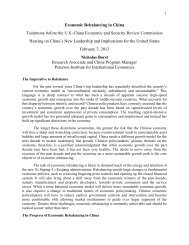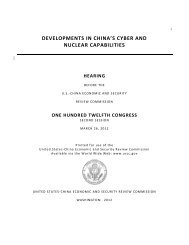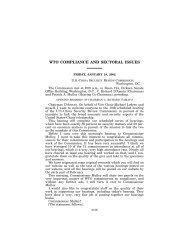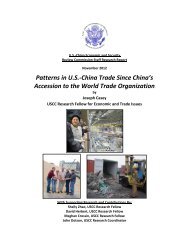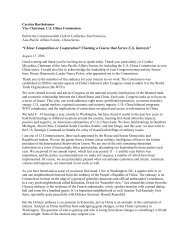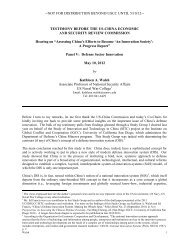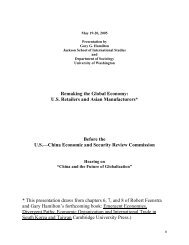2011 report to congress - U.S.-China Economic and Security Review ...
2011 report to congress - U.S.-China Economic and Security Review ...
2011 report to congress - U.S.-China Economic and Security Review ...
You also want an ePaper? Increase the reach of your titles
YUMPU automatically turns print PDFs into web optimized ePapers that Google loves.
dkrause on DSKHT7XVN1PROD with $$_JOB175ers in Japan, Taiwan, Europe, <strong>and</strong> the United States.‡ The perpetra<strong>to</strong>rsthen used information about the compromised RSA securityproduct in order <strong>to</strong> target a number of the firm’s cus<strong>to</strong>mers,including at least three prominent entities within the U.S. defenseindustrial base. Those intrusions <strong>and</strong> intrusion attempts, according<strong>to</strong> some <strong>report</strong>s, also originated in <strong>China</strong> <strong>and</strong> appeared <strong>to</strong> be statesponsored. 132Many intrusions linked <strong>to</strong> <strong>China</strong> involve numerous victims,sometimes spanning sec<strong>to</strong>rs <strong>and</strong> national borders. 133 When researchersidentify <strong>and</strong> gain access <strong>to</strong> elements the systems used <strong>to</strong>effectuate the intrusion, such as servers that maintain contact withcompromised systems, it becomes possible <strong>to</strong> identify related victims.The breadth of victims itself can suggest state involvement ifthe diversity in targets exceeds any conceivable scope of interest <strong>to</strong>a lone, subnational ac<strong>to</strong>r (or even a coalition of subnational ac<strong>to</strong>rs).*Although links <strong>to</strong> <strong>China</strong> are speculative <strong>and</strong> come from secondary<strong>report</strong>ing, a case study by McAfee, called Operation ShadyRAT [remote access <strong>to</strong>ol], illustrates this principle.† The <strong>2011</strong>study catalogues a series of penetrations affecting over 70 victimorganizations that span numerous sec<strong>to</strong>rs, including federal, state,local, <strong>and</strong> foreign governments; energy <strong>and</strong> heavy industry; electronics<strong>and</strong> satellite communications; defense contrac<strong>to</strong>rs; financialindustry; <strong>and</strong> international sports institutions, think tanks, <strong>and</strong>nonprofits. 134 In discussing the possible ac<strong>to</strong>rs behind the penetrations,the <strong>report</strong> states:The [perpetra<strong>to</strong>rs’] interest in the information held at theAsian <strong>and</strong> Western national Olympic Committees, as wellas the International Olympic Committee (IOC) <strong>and</strong> theWorld Anti-Doping Agency in the lead-up <strong>and</strong> immediatefollow-up <strong>to</strong> the 2008 Olympics was particularly intriguing<strong>and</strong> potentially pointed a finger at a state ac<strong>to</strong>r behind theintrusions, because there is likely no commercial benefit <strong>to</strong>be earned from such hacks. The presence of political nonprofits,such as a private western organization focused onpromotion of democracy around the globe or a US nationalsecurity think tank is also quite illuminating. Hacking theUnited Nations or the Association of Southeast Asian Na-‡ The <strong>to</strong>ol is probably available from Chinese websites <strong>and</strong> chat rooms. Whether the serversin mainl<strong>and</strong> <strong>China</strong> were the true origin of the comm<strong>and</strong> traffic can only be verified with cooperationfrom <strong>China</strong> Unicom, a Chinese state-owned firm <strong>and</strong> the relevant network opera<strong>to</strong>r.Joe Stewart, ‘‘HTran <strong>and</strong> the Advanced Persistent Threat’’ (Atlanta, GA: Dell SecureWorks, August3, <strong>2011</strong>). http://www.secureworks.com/research/threats/htran/; <strong>and</strong> Gregg Keizer, ‘‘Researcherfollows RSA hacking trail <strong>to</strong> <strong>China</strong>,’’ Computerworld, August 4, <strong>2011</strong>. http://www.computerworld.com/s/article/9218857/ResearcherlfollowslRSAlhackingltraill<strong>to</strong>l<strong>China</strong>.* This applies for penetrations that seek <strong>to</strong> maintain surveillance capabilities or extract informationwithout inherent monetary value. Considerations of target scope do not apply for penetrationstargeting personally identifiable or sensitive financial information, along with penetrationsthat seek <strong>to</strong> compromise systems for the purposes of creating a botnet.† For the original <strong>report</strong>, see Dmitri Alperovitch, Revealed: Operation Shady RAT (SantaClara, CA: McAfee: August <strong>2011</strong>). http://www.mcafee.com/us/resources/white-papers/wp-operationshady-rat.pdf.The <strong>report</strong> itself does not mention <strong>China</strong>. For suggestions that <strong>China</strong> may bebehind the intrusions, see Ellen Nakashima, ‘‘Report on ‘Operation Shady RAT’ identifieswidespread cyber-spying,’’ Washing<strong>to</strong>n Post, August 3, <strong>2011</strong>. http://www.washing<strong>to</strong>npost.com/national/national-security/<strong>report</strong>-identifies-widespread-cyber-spying/<strong>2011</strong>/07/29/gIQAoTUmqIls<strong>to</strong>ry.html; <strong>and</strong> Mathew J. Schwartz <strong>and</strong> J. Nicolas Hoover, ‘‘<strong>China</strong> Suspected of Shady RAT Attacks,’’InformationWeek, August 3, <strong>2011</strong>. http://www.informationweek.com/news/security/attacks/231300165.VerDate Nov 24 2008 13:46 Nov 10, <strong>2011</strong> Jkt 067464 PO 00000 Frm 00187 Fmt 6601 Sfmt 6601 G:\GSDD\USCC\<strong>2011</strong>\067464.XXX 067464



